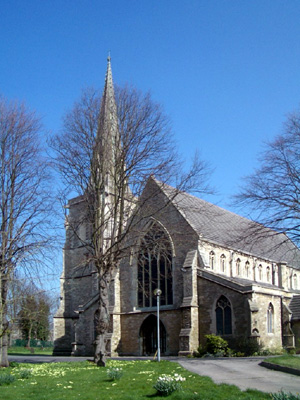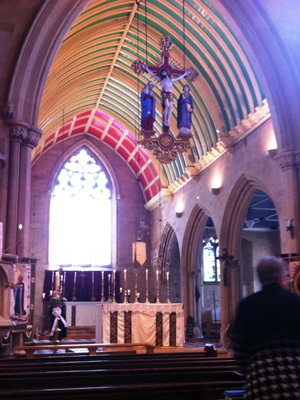| |
 |
 |
 |
| Comment on this report, or find other reports. |
 |
| Our Mystery Worshippers are volunteers who warm church pews for us around the world. If you'd like to become a Mystery Worshipper, start here. |
 |
| Find out how to reproduce this report in your church magazine or website. |
|
|
| 3149: St Mark's, Swindon, England |
 |
 |
 |
Mystery Worshipper: Bunbury O'Remus.
The church: St Mark's, Swindon, Wiltshire, England.
Denomination: Church of England, Diocese of Bristol. They are a Forward in Faith church under the care of the Bishop of Ebbsfleet.
The building: It is an early work by the distinguished architect Sir Gilbert Scott, known for his workhouses and lunatic asylums as well as numerous churches and cathedrals. It was dedicated on 25 April 1845. It is highly visible from the main London-Bristol railway line and has a 140 foot tall spire visible across the town of Swindon. Inside, the nave is in five bays, with two aisles, a large sanctuary, and a font with suspended oak cover in the form of a spire. A hanging pyx was given in 1983 as a gift to the church by British Rail’s local engineering works to mark the latter's 150th anniversary.
The church: St Mark’s describes itself as "a Church of England parish in the Catholic tradition" and is one of a number of worshiping communities (and church buildings – with dedications to St Saviour, St Luke and St Aldhelm) now together under one priest and the parish of Swindon New Town. It has a long musical tradition – Benjamin Britten composed his Festival Te Deum for the centenary of the church.
The neighbourhood: Swindon, a town of about 180,000 souls, is within the ceremonial county of Wiltshire. St Mark’s sits adjacent to the area known as Swindon Railway Village, comprised of 280 stone-built two storey cottages which, like the church, were constructed for the community working at the nearby locomotive depot and works for the Great Western Railway in Swindon.
The cast: Although the pew leaflet didn’t tell me, the website reveals the celebrant/preacher was the Revd Dexter Bracey, parish priest, supported by a cast of five robed servers.
The date & time: Easter Sunday, 16 April 2017, 10.30am.
What was the name of the service?
Procession and Sung Mass of Easter Day.
How full was the building?
There were about 50 in the congregation, though (at a guess) the church could comfortably have seated 150 or more.
Did anyone welcome you personally?
A lady with a curious red feather fascinator atop her hair, which clashed gloriously with her elegant pink jacket, said "Good morning" and handed me a pew leaflet on my arrival. Having sat down, I quickly cottoned on that I would also need a hymn book, so went in search of one. By the time I had resumed my seat, a keen-eyed parishioner had spotted that the books hadn’t been handed out, and had thoughtfully placed one in my pew.
Was your pew comfortable?
Not very. Pine pews, penitential in a Tractarian way – one’s knees sloped down and consequently the body slid gently, but determinedly, towards a kneeling position from the red bench-length cushions.
How would you describe the pre-service
atmosphere?
Quiet and reverential, though one could hear the choir rehearsing in the distance, and the sound of the ring of the church’s eight bells. The organ was played about five minutes before the service was due to start, and carried on playing to cover the late arrival of the celebrant – presumably having hot-footed it in his cassock and biretta from another of his parishes that had an earlier service.
What were the exact opening words of the
service?
The opening line of the processional hymn “Hail Thee, Festival Day!” First spoken words were: “In the name of the Father, and of the Son, and of the Holy Spirit.”
What books did the congregation use during the
service?
The text of the service was printed and could be followed in a pew leaflet, alongside the New English Hymnal for hymn words – except strangely the words of the unsingable (yet lovely) processional hymn were printed in the leaflet. The copyright in the pew leaflet tells me the service came from Common Worship.
What musical instruments were played?
A rather fine organ, played expertly by Philip Burnett, Ph.D., director of music. The liturgy was accompanied by a small but more than competent (albeit quiet) choir. The sadness perhaps was that the music to the mass setting was not printed in the pew leaflet, or seemingly available, so for visitors who did not know it (I believe it was David Thorne’s Mass of St Thomas) it was difficult to join in. But then, the congregation didn’t sing much of it either. The anthem, an arrangement by Charles Wood of This Joyful Eastertide, was sung well; the soprano deserves a special mention in dispatches.
Did anything distract you?
The rhythmic movement of the celebrant shifting his weight from foot to foot while preaching. He was either limbering up for a marathon, recalling a two-step dance from his youth, or perhaps he was going on that afternoon to audition for Lord of the Dance. And quite what he was focussing on, with his eyes seemingly searching out something in the distance, I never discovered. Perhaps it was in anticipation of the imagined packed Albert Hall in his new role in the chorus line of the aforementioned show.

Was the worship stiff-upper-lip, happy clappy, or
what?
This was Ango-Catholic worship, maniple and biretta and all, and absolutely not for any who might have an outbreak of Protestant throat (there were clouds of incense). The celebrant started in a cope for the procession to the Easter garden, but the opening hymn sadly was cut short rather than the procession taking another lap. He kept his cope on for the subsequent Vidi aquam (sprinkling of the people with holy water) but then didn’t change into vestments for mass until the offertory. And it was curious, given this was the first mass of Easter at the church (there had been no vigil), why the lovely hanging pyx still held some reserved Sacrament that was then used for distribution of communion.
Exactly how long was the sermon?
12 minutes.
On a scale of 1-10, how good was the preacher?
6 – The Revd Dexter Bracey had no notes and was fluent and clear, speaking without hesitation or repetition (save for the rhythmic swaying) – though perhaps might be said to have had a little deviation, as notes might have linked his thoughts into a coherent whole. And despite his eloquence, I think he was as surprised as any of us when he came to an end and abruptly finished his articulated thoughts.
In a nutshell, what was the sermon
about?
Talk of bells, by way of the Church of the Holy Sepulchre in Jerusalem and the cacophony of noise and liturgy therein, into the joy of Easter.
Which part of the service was like being in
heaven?
The gorgeous spring sunlight streaming through the windows and catching incense smoke surrounding the hanging pyx like a halo.
And which part was like being in... er... the other place?
Well ... not much really, save for the vacant looks and swaying from the pulpit. Though perhaps ditch the maniple and the biretta. They added nothing to the solemnity of the occasion or the gaiety of nations.
What happened when you hung around after the service looking lost?
I sat in my pew at the end of the 80-minute service listening to the organ. I was almost immediately pounced on by a lady who commented on my lovely singing voice and would I like to join the choir? I said I was visiting. Whereupon with a throw-away “Pity” she turned on her heel and left me hanging. A youngish couple wished me a happy Easter as they made their way to a rather impressive and large Easter garden.
At the end of the organ voluntary, I left my pew and passed the priest, who was intent in conversation with a couple, so my own little overture as I passed him went unnoticed.
How would you describe the after-service
coffee?
I was desperate for the loo and a drink, as I had traveled some way to get here. But the hall's entrance, cleverly concealed at the back of the nave under a 1970s refurbished pipe organ, was blocked by a huddle of woman talking ten to the dozen, and it felt rude to push past. An "Excuse me" did not cease the chatter or allow me to pass either, so I left the church. Perhaps I should have offered to join the choir after all. I'll bet their members get a loo and refreshment break.
How would you feel about making this church your regular (where 10 = ecstatic, 0 = terminal)?
8 – Certainly better than a lot on offer in the Diocese of Bristol. With a choir and reasonable liturgy, I could be happy here. But perhaps noticing the stranger in your midst would be a good observance in Eastertide and beyond.
Did the service make you feel glad to be a
Christian?
Indeed. Christus surrexit hodie, sicut dixit! (Christ arose today, just as he said.) Alleluia.
What one thing will you remember about all this in seven days' time?
The lovely hanging pyx. |
|
|
 |
 |
 |
| We rely on voluntary donations to stay online. If you're a regular visitor to Ship of Fools, please consider supporting us. |
 |
 |
 |
| The Mystery Pilgrim |
 |
| One of our most seasoned reporters makes the Camino pilgrimage to Santiago de Compostela in Spain. Read here. |
 |
 |
 |
| London churches |
 |
| Read reports from 70 London churches, visited by a small army of Mystery Worshippers on one single Sunday. Read here. |
| |
|
|
|
|


